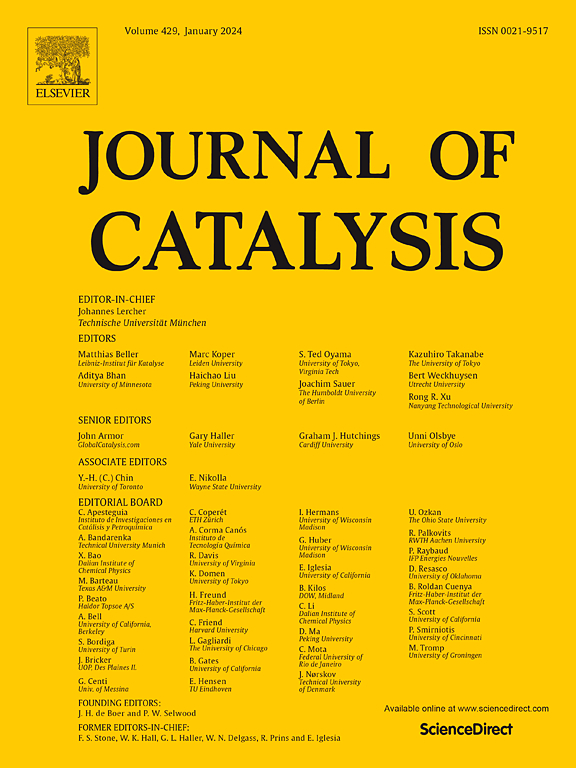Carbon dioxide hydrogenation to formate catalyzed by highly active Ru-tris(pyrazolyl)methane complexes
IF 6.5
1区 化学
Q2 CHEMISTRY, PHYSICAL
引用次数: 0
Abstract
In the quest for novel, active ruthenium(II) complexes for homogeneous catalytic CO2 hydrogenation to formate, a small library of cationic Ru(κ3-tpm) complexes [tpm = tris(pyrazolyl)methane] bearing different ancillary ligands were tested under various reaction conditions, with and without the addition of a Lewis acid co-catalyst. Under optimized conditions (80 bar, 120 °C) and in the presence of LiOTf, TONs > 54000 were obtained in single batch runs with the complex [RuCl(κ3-tpm)(PPh3)(CH3CN)]Cl (1). Mechanistic studies using NMR spectroscopy and DFT calculations were also carried out to elucidate key steps and the energies associated with the reaction pathway, which allowed for the proposal of a catalytic mechanism.


高活性ru -三(吡唑基)甲烷配合物催化二氧化碳加氢生成甲酸酯
为了寻找新的、活性的钌(II)配合物,用于均相催化CO2加氢生成甲酸,在不同的反应条件下,在添加和不添加Lewis酸共催化剂的情况下,测试了一个带有不同辅助配体的小型阳离子Ru(κ3-tpm)配合物[tpm = tris(吡唑基)甲烷]。在优化条件(80 bar, 120 °C)和LiOTf存在下,以配合物[RuCl(κ3-tpm)(PPh3)(CH3CN)]Cl(1)为原料,单批生产得到了TONs >; 54000。利用核磁共振波谱和DFT计算进行机理研究,以阐明与反应途径相关的关键步骤和能量,从而提出催化机理
本文章由计算机程序翻译,如有差异,请以英文原文为准。
求助全文
约1分钟内获得全文
求助全文
来源期刊

Journal of Catalysis
工程技术-工程:化工
CiteScore
12.30
自引率
5.50%
发文量
447
审稿时长
31 days
期刊介绍:
The Journal of Catalysis publishes scholarly articles on both heterogeneous and homogeneous catalysis, covering a wide range of chemical transformations. These include various types of catalysis, such as those mediated by photons, plasmons, and electrons. The focus of the studies is to understand the relationship between catalytic function and the underlying chemical properties of surfaces and metal complexes.
The articles in the journal offer innovative concepts and explore the synthesis and kinetics of inorganic solids and homogeneous complexes. Furthermore, they discuss spectroscopic techniques for characterizing catalysts, investigate the interaction of probes and reacting species with catalysts, and employ theoretical methods.
The research presented in the journal should have direct relevance to the field of catalytic processes, addressing either fundamental aspects or applications of catalysis.
 求助内容:
求助内容: 应助结果提醒方式:
应助结果提醒方式:


